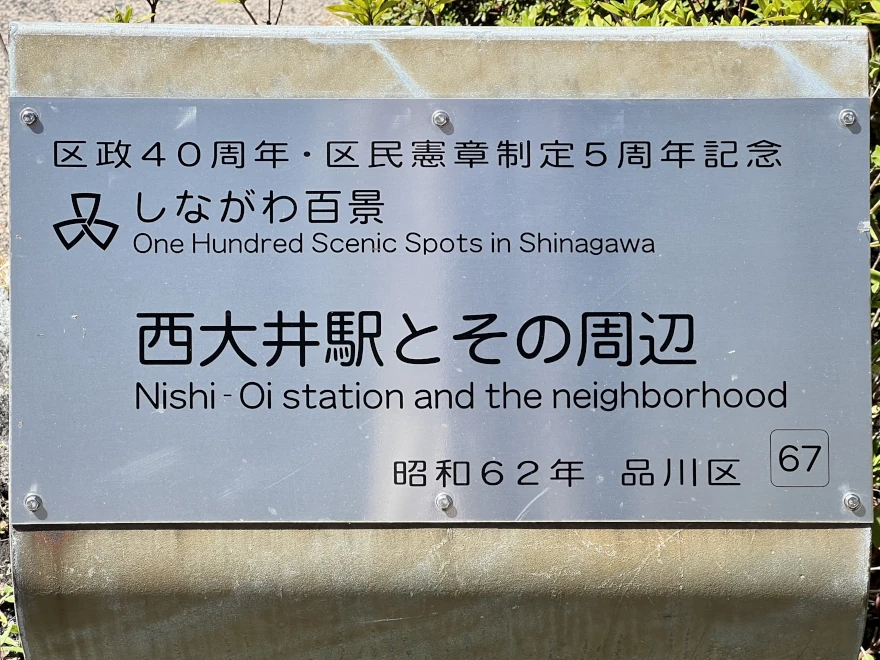Nishi-Ōi – Shinagawa’s Quiet Back Gate
Nishi-Ōi Station (西大井駅) and its surrounding area provide a calm residential counterpoint to the hustle of Shinagawa’s busier urban centres. Located in the western edge of the ward near the border with Ōta Ward, this stop on the JR Shōnan-Shinjuku and Yokosuka Lines connects Shinagawa directly to both Yokohama and Saitama, while remaining tucked into a family-friendly zone of parks, low-rise housing, and local shops.
Though not typically a tourist destination, Nishi-Ōi was selected for the Shinagawa Hyakkei due to its significance as a quiet, livable node within Tokyo’s massive rail network. It’s the kind of place where life unfolds at a slower pace — with schoolkids walking tree-lined paths and seniors chatting on benches. A model of the city’s daily, down-to-earth reality.
🚉 Nishi-Ōi station: A Local Station for Local People
Opened in 1986, Nishi-Ōi Station sits just west of the busy Ōimachi rail corridor. Unlike its larger counterparts, it was designed to serve the growing residential developments of the time. Today, it’s popular with commuters heading north and south on the Shōnan-Shinjuku Line, as well as families who appreciate its low-key surroundings.
The station building is modest but efficient, with elevators, bike parking, and a handful of small eateries and bakeries nearby. A quiet plaza in front of the station often hosts community notices and seasonal flower displays.
🌳 Parks, Schools, and Daily Life
The area around the station is dotted with schools, nurseries, and green spaces like Nishi-Ōi Park and Kashima Jinja. On weekends, it’s common to see youth baseball games in full swing and parents enjoying picnics nearby. For those seeking a taste of true local Tokyo life, this is it — unpolished, lived-in, and honest.
Nishi Ōi – Optics Street (光学通り)
Optics Street (光学通り): One of Nishi-Ōi’s best-known thoroughfares, Optics Street gets its name from the historic presence of Nikon Corporation, Japan’s premier optical technology company. Once home to major facilities involved in the development of precision instruments and camera lenses, the street preserves this legacy in name. Today, it’s a quiet local road lined with shops, homes, and small businesses, reflecting the area’s shift from industry to residential calm—yet the name still evokes the scientific ingenuity that helped shape modern Japan.
🧭 Visitor Information
Address: Around 2-10 Nishi-Ōi, Shinagawa-ku, Tokyo 140-0015
Best season: Spring and Autumn for outdoor strolling
Admission: Free
Official Info: None
Note: A very residential area — little sightseeing appeal, but great for peaceful urban exploration.
Where is it?
| what3words | ///frames.retain.doctors |
| latitude longitude | 35.60168, 139.72226 |
| Nearest station(s) | Nishi-Ōi Station (JR Shōnan-Shinjuku & Yokosuka Lines) |
| Nearest public conveniences | In or around the station area |
Show me a sign.

The Hyakkei signboard can be found near the north exit plaza, affixed to a small display pedestal beside the flower bed.
💬 Withervee says…
There’s beauty in normality. If you want to experience Shinagawa beyond the postcards, this is a good place to begin. Bonus points for the spring azaleas.
Don’t expect tourist services, though. This is a bench-and-bento sort of adventure.
A Sign but not a Scene
If you leave Nishi Ōi station and go south up the slope to the next crossroads you will come to Optics Street (Kogaku-dori). Cross the road and turn left and walk a few minutes you will see a humble stone waymarker on the side of the road. (It’s not that humble as it has an official sign next to it telling you what it is – in Japanese).
This the oldest stone waymarker in all of Shinagawa. Carved in 1695 (Genroku 8) by a local Buddhist fellowship led by the monk Jakushō and 58 members of a nenbutsu kō, the marker once stood beside a stone bridge built over the Shinagawa Aqueduct. Its purpose was to ensure the safety of travelers and to honor the religious work of those who maintained it.
Designated as Shinagawa City Historic Site #18, the 1.18-meter andesite pillar has “Namu Amida Butsu” etched on the front, with directions to two major religious sites engraved on either side: “From here, to Ikegami Honmon-ji” on the left, and “From here, to Okusawa Kuhonbutsu” on the right. These routes once linked the old Tōkaidō Road to the Nakahara Kaidō.
The usually shiny Hyakkei plaques now dot Shinagawa’s landscape, but this Edo-period guidepost is still there—centuries ahead of the trend. If anything deserves the title of the ward’s original scenic sign, it’s this.
Site Character
- Lifestyle 生活 (Seikatsu): ✔️
- Historical Significance 歴史 (Rekishi): ❌
- Atmosphere/Natural Features 風土 (Fūdo): ✔️
Who in their right mind would vote for this?
- Commuters
- Families with kids
- Local walkers
- Trainspotters
- Nikon employees
Further reading
While you’re there…
Nearby Spots: Tomb of Hirobumi Itō and Yōgyokuin Nyorai-ji
Also 5 minutes from the station is Nikon Global HQ Building with the Nikon Museum. Admission to the museum is free.

